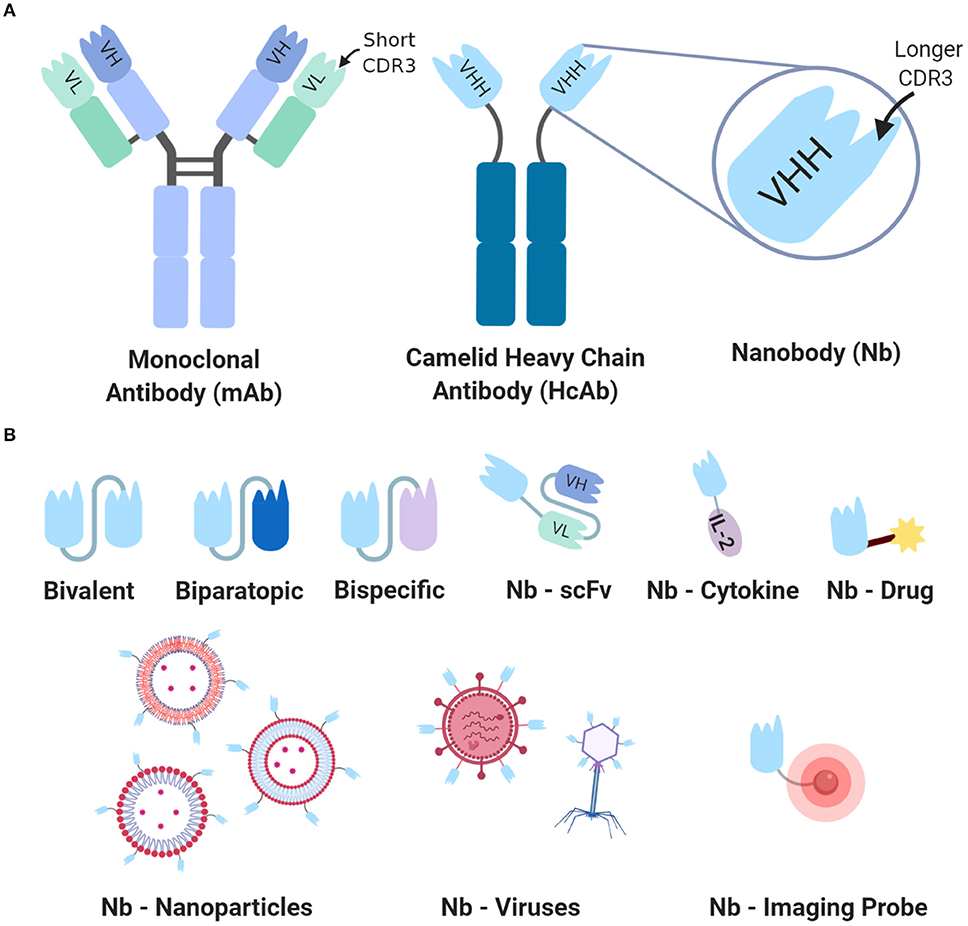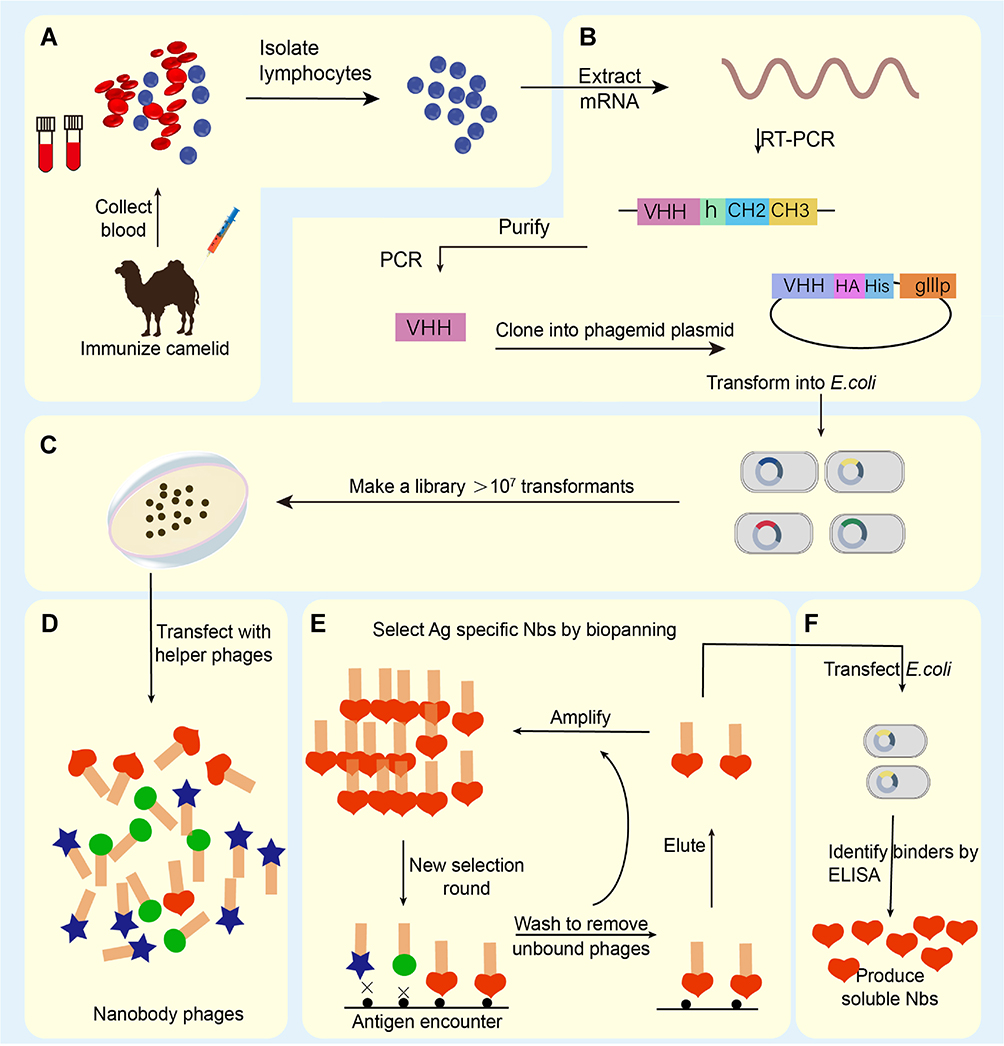What is Single-domain Antibody
Single-domain antibodies are the single antigen-binding domains of heavy chain-only antibodies (HCAbs) that are found in camelids. They are also known as variable domains of HCAbs (VHHs). Single-domain antibodies have many unique properties such as small size (~15 kDa), excellent solubility, superior stability, low immunogenicity, high affinity and specificity, and easy production and engineering. Compared to conventional monoclonal antibodies (mAbs), Single-domain antibodies (sdAbs) have several advantages such as better tissue penetration, faster blood clearance, and lower manufacturing costs. The first single-domain antibody-based drug was approved in 2018 for the treatment of acquired thrombotic thrombocytopenic purpura, demonstrating the clinical potential of this format.

Fig.1 General single-domain antibody structure and types of single-domain antibodies. (Yang EY, 2020)
Single-domain Antibody Generation Methods
Single-domain antibodies can be generated from different sources and by different strategies. The most common method is to immunize a camelid with the target protein or protein complex and isolate the single-domain antibody-encoding genes from the B lymphocytes of the immunized animal. The genes are then cloned into a phage display vector and screened for antigen-specific binders by panning. Alternatively, synthetic single-domain antibody libraries can be constructed in vitro by randomizing the codons encoding the antigen-binding loops of a single-domain antibody scaffold. These libraries can also be screened by phage display or other selection methods such as yeast surface display, ribosome display, or mRNA display. Both methods have advantages and disadvantages. The immunization-based method can generate Single-domain antibodies (sdAbs) with high affinity and specificity, but it requires animal immunization and ethical approval. The synthetic library method can overcome these limitations, but it may generate Single-domain antibodies (sdAbs) with lower affinity and stability. Moreover, the synthetic library method may not capture the natural diversity and maturation of Single-domain antibodies (sdAbs) that occur in vivo. Therefore, the choice of the method depends on the availability of the target protein, the ethical considerations, and the desired properties of the Single-domain antibodies (sdAbs).

Fig.2 Schematic overview of single-domain antibody generation. (Sun S, 2021)
Single-domain Antibody in Diagnostics
Single-domain antibodies have shown great potential as diagnostic tools in various fields of biotechnology. They can be used to detect and isolate different analytes, such as proteins, hormones, toxins, drugs, and pathogens, using biosensing and affinity capture methods. They can also be used to facilitate the crystallization of proteins for structural analysis. Moreover, they can be used to image biological processes in living organisms using different modalities, such as fluorescence imaging, magnetic resonance imaging (MRI), positron emission tomography (PET), and single-photon emission computed tomography (SPECT). Single-domain antibodies have many advantages over conventional antibodies in diagnostic applications, such as small size, high solubility, high stability, low immunogenicity, and easy labeling.
Clinical Data of Single-domain Antibody-Based Therapeutics
Single-domain antibodies have shown great potential for the development of novel and effective therapeutics for various diseases, especially cancer. Due to their small size, high stability, strong affinity, low immunogenicity, and ease of engineering, Single-domain antibodies (sdAbs) can overcome some of the limitations of conventional antibodies, such as poor tissue penetration, high production cost, and resistance development. As therapeutic agents, Single-domain antibodies (sdAbs) enable a targeted therapy by lesion-specific delivery of drugs and effector domains, thereby improving the specificity and efficacy of the therapy. Moreover, Single-domain antibodies (sdAbs) can modulate immune responses by binding to immune checkpoints, cytokines, or receptors on immune cells. Single-domain antibodies can also be used as gene therapy vectors to deliver therapeutic genes into target cells. In this section, we will review some of the recent advances and applications of single-domain antibody-based therapeutics for various diseases.
Single-domain antibodies have entered clinical trials for a wide range of indications, such as inflammation, cancer, infectious diseases, and cardiovascular disorders. Among them, the most advanced single-domain antibody drug is a bivalent single-domain antibody that targets von Willebrand factor (vWF) and prevents platelet aggregation. It was approved by the European Medicines Agency (EMA) and the US Food and Drug Administration (FDA) in 2018 and 2019, respectively, for the treatment of patients with acquired thrombotic thrombocytopenic purpura (aTTP), a rare and life-threatening blood clotting disorder.
Table 1. Approved or under review single-domain antibody drugs
|
Drug name
|
Target
|
Approval date
|
Indication
|
Population
|
Region
|
|
Efgartigimod
|
FcRn
|
Under review
|
Myasthenia gravis
|
Adults
|
EU/US
|
|
Ziritaxestat
|
NOX1/4
|
Under review
|
Systemic sclerosis-associated interstitial lung disease
|
Adults
|
EU
|
There are many other single-domain antibody drugs that are in different phases of clinical trials. The majority of them are for oncology indications, targeting various antigens such as epidermal growth factor receptor (EGFR), programmed cell death protein 1 (PD-1), human epidermal growth factor receptor 2 (HER2), and receptor tyrosine-protein kinase erbB-2 (ErbB2). The main sponsors of these trials are biotechnology companies such as Ablynx (a subsidiary of Sanofi), argenx, Confo Therapeutics, and Camel-IDS.
Table 2. Ongoing clinical trials of single-domain antibody drugs
|
Drug name
|
Target
|
Clinical trial phase
|
Indication
|
|
ALX-0171
|
RSV F protein
|
Phase 2b
|
Respiratory syncytial virus infection
|
|
ALX-0061
|
IL-6R
|
Phase 2b/3
|
Rheumatoid arthritis
|
|
ARGX-113
|
FcRn
|
Phase 3
|
Immune thrombocytopenia
|
|
ARGX-110
|
CD70
|
Phase 2/3
|
Cutaneous T cell lymphoma
|
|
ARGX-111
|
MET
|
Phase 1/2a
|
Solid tumors
|
|
ARGX-115
|
GARP-TGFβ complex
|
Phase 1/2a
|
Solid tumors
|
|
CFZ533
|
CD40
|
Phase 2a/b
|
Autoimmune diseases
|
|
ALX148
|
CD47/SIRPα complex
|
Phase 1/2a/b/c
|
Hematological malignancies and solid tumors
|
|
CONAN-1000/2000/3000 series
|
GPCRs or other membrane proteins
|
Preclinical/Phase 1
|
Various diseases
|
References
1. Sun S, et al. Single-domain antibody (sdAb): A Small Antibody with Big Implications for Tumor Therapeutic Strategy. Int J Nanomedicine. 2021 Mar 22;16:2337-2356
2. Muyldermans S. A guide to: generation and design of Single-domain antibodies (sdAbs). FEBS J. 2021 Apr;288(7):2084-2102.
3. Deszyński P, et al. INDI-integrated Single-domain antibody (sdAb) database for immunoinformatics. Nucleic Acids Res. 2022 Jan 7;50(D1):D1273-D1281.
4. Kunz P, et al. The structural basis of Single-domain antibody (sdAb) unfolding reversibility and thermoresistance. Sci Rep. 2018 May 21;8(1):7934.
5. Yang EY, et al. Single-domain antibodies (sdAbs): Next Generation of Cancer Diagnostics and Therapeutics. Front Oncol. 2020 Jul 23;10:1182.
6. Jin BK, et al. Single-domain antibodies (sdAbs): A Review of Generation, Diagnostics and Therapeutics. Int J Mol Sci. 2023 Mar 22;24(6):5994.
7. Steeland S, et al. Single-domain antibodies (sdAbs) as therapeutics: big opportunities for small antibodies. Drug Discov Today. 2016 Jul;21(7):1076-113.
8. Huo J, et al. A potent SARS-CoV-2 neutralising Single-domain antibody (sdAb) shows therapeutic efficacy in the Syrian golden hamster model of COVID-19. Nat Commun. 2021 Sep 22;12(1):5469.
Our products and services are for research use only, and not for use in diagnostic or therapeutic procedures.
Welcome! For price inquiries, we will get back to you as soon as possible.
To order, please email
INQUIRY










